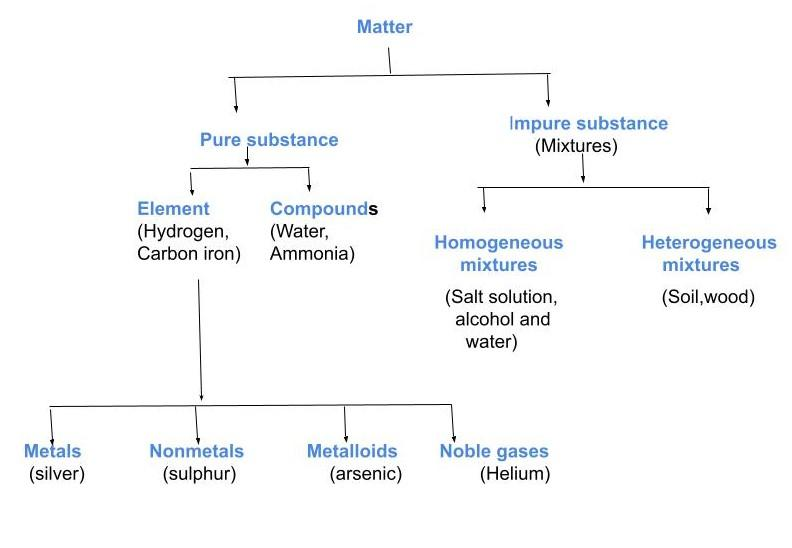
(a) What are the three classes of matter? Give one example of each type.
(b) Draw the flowchart for the schematic representation of different types of matter.
Answer
422.7k+ views
Hint: All in your environment is made up of matter. Atoms and substances are made up of minuscule pieces of matter. The atoms that make up the objects you see and touch every day are made up of these atoms. All that has mass and occupies space is referred to as matter (it has volume).
Complete answer:
-Matter is described as something that takes up space, has mass, and exerts resistance. The mass of a body is the sum of matter found within it. Strong, liquid, and gaseous matter are the three physical states of matter. Matter is classified chemically into pure and impure (mixture) substances.
Solid, liquid, and gas are the three distinct physical states of matter that matter can take in most environments.
Solid: A substance that preserves its size and form in the absence of a container; a substance whose molecules can only vibrate freely.
Example: Brick
Liquid: Since its molecules are loosely packed and continually moving, this material flows and maintains no definite form. It conforms to the shape of its container while maintaining the same amount.
Example: Water
Gas: A material that can only be stored if it is fully encased in a jar (or kept together by gravitational pull); a substance whose molecules have minimal intermolecular interactions and can freely travel.
Example: Hydrogen
b)

Note:
Antimatter is matter made up of antiparticles of the particles that make up ordinary matter. When a particle and its antiparticle collide, they annihilate; that is, according to Albert Einstein's equation
Complete answer:
-Matter is described as something that takes up space, has mass, and exerts resistance. The mass of a body is the sum of matter found within it. Strong, liquid, and gaseous matter are the three physical states of matter. Matter is classified chemically into pure and impure (mixture) substances.
Solid, liquid, and gas are the three distinct physical states of matter that matter can take in most environments.
Solid: A substance that preserves its size and form in the absence of a container; a substance whose molecules can only vibrate freely.
Example: Brick
Liquid: Since its molecules are loosely packed and continually moving, this material flows and maintains no definite form. It conforms to the shape of its container while maintaining the same amount.
Example: Water
Gas: A material that can only be stored if it is fully encased in a jar (or kept together by gravitational pull); a substance whose molecules have minimal intermolecular interactions and can freely travel.
Example: Hydrogen
b)

Note:
Antimatter is matter made up of antiparticles of the particles that make up ordinary matter. When a particle and its antiparticle collide, they annihilate; that is, according to Albert Einstein's equation
Recently Updated Pages
Express the following as a fraction and simplify a class 7 maths CBSE

The length and width of a rectangle are in ratio of class 7 maths CBSE

The ratio of the income to the expenditure of a family class 7 maths CBSE

How do you write 025 million in scientific notatio class 7 maths CBSE

How do you convert 295 meters per second to kilometers class 7 maths CBSE

Write the following in Roman numerals 25819 class 7 maths CBSE

Trending doubts
How many ounces are in 500 mL class 8 maths CBSE

Summary of the poem Where the Mind is Without Fear class 8 english CBSE

Advantages and disadvantages of science

The LCM and HCF of two rational numbers are equal Then class 8 maths CBSE

In Indian rupees 1 trillion is equal to how many c class 8 maths CBSE

How many ten lakhs are in one crore-class-8-maths-CBSE





